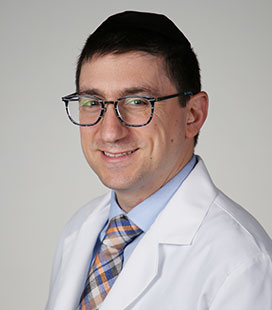
Aron Schwarcz, MD, interventional cardiologist
Advancements in Technology Help Patients Avoid Heart Surgery
Several new advancements in technology used to treat heart disease can potentially help people with heart disease avoid open heart surgery. Dr. Aron Schwarcz, an interventional cardiologist with Englewood Health, explains two of these new tools used in Englewood Hospital’s Cardiac Catheterization Lab.
What is a CTO?
A chronic total occlusion (CTO) occurs when a coronary artery (a vessel supplying blood to your heart) is completely blocked for more than three months. “There are many people living with chest pain and with other symptoms, such as shortness of breath or general fatigue, for which the source may be a chronic total occlusion of an artery, but it may go undetected,” says Dr. Schwarcz. “There is a large population of people not getting adequately treated.”
Dr. Schwarcz co-led the development of the Chronic Total Occlusion (CTO) program at Englewood Health, the only one of its kind in northern New Jersey. Now in its third year, the CTO program has a 90-percent success rate and, with the new technology, doctors are able to treat even more complex cases.
Who is the typical patient qualifying for the CTO program?
“Patients who have symptoms and a diagnostic catheterization, or angiogram, showing a CTO, but heart muscle in the area still functioning,” may be eligible for the CTO program, shares Dr. Schwarcz. “If that is their only blockage; or if they are not a candidate for cardiac surgery, for example because of health, age, or previous cardiac surgery; or if they are looking for alternatives to open heart surgery, CTO treatment may be an option.”
How is CTO treated?
The procedure is performed in the cardiac catheterization lab similar to other coronary interventions, where a catheter is placed into the artery of the leg or arm and advanced to the heart. “With new technology we can either go through the blockage or around it using the vessel wall, or go through the nearby collateral vessels in the heart and backward through the blockage,” explains Dr. Schwarcz. “Then we open the artery with a balloon angioplasty and place a stent.”
What if I’ve previously attempted treatment for a CTO in the past and it failed?
“Even if there has been a previous attempt at fixing a CTO which wasn’t successful, it is still possible that, with the new technology, it can be successful now,” asserts Dr. Schwarcz. “It’s worth an evaluation,” he adds.
What other new innovations are being used in the Cath Lab?
The Impella® heart pump is a device that supports the heart’s function during procedures, and allows Englewood Hospital’s interventional cardiologists to perform more complex procedures in a safe and efficient manner. “Like other procedures performed in the Cath Lab, the Impella is inserted into the artery in the leg using a tiny puncture. It is then advanced with wires into the main pumping chamber of the heart,” says Dr. Schwarcz. “It helps support the heart’s pumping function.”
Why is the new technology important in CTO treatment?
“We can now perform interventional cardiology procedures for patients who, in the past, would have been assessed as poor or high-risk candidates for a procedure, especially those with very poor heart muscle function. For example, patients considered high-risk surgical candidates or evaluated as too high-risk for surgery, we can now treat with stenting procedures. It gives us another alternative to surgery,” explains Dr. Schwarcz. “Also, for people who come to the hospital with heart attacks and super low blood pressure, we can improve survival by placing an Impella. Patients who are in cardiogenic shock (for example, from a severe heart attack) can be treated in a safe manner, where in the past there might not have been an option for them. This is especially important for patients who are too sick for cardiac surgery. We now have more treatment options for saving a person’s life.”
Doctor’s Orders? Unwind.
Dr. Schwarcz emphasizes the importance of taking time to relax. “It’s always important to occasionally disconnect. Give yourself time to unwind at the end of the day. Listen to music, read a book, or do whatever works for you to unwind.” As for Dr. Schwarcz, he enjoys lingering over a Sunday breakfast with his family and playing basketball outside with his kids. Dr. Schwarcz recommends spending time with family. “Reconnecting with family and friends can be very important.”
Posted September 2018

Aron Schwarcz, MD, interventional cardiologist
